英语说课基本流程
小学英语说课的基本步骤

小学英语说课的基本步骤一、引言英语作为一门外语课程,对于小学生的语言能力的培养具有重要的意义。
而在教师教学过程中,一节成功的英语课程需要经过一系列的准备与布置。
本文将从引言、课程目标、教学重点与难点、教学设计、教学过程、教学手段、教学评价等方面介绍小学英语说课的基本步骤。
二、课程目标在开始准备教学过程之前,教师首先需要明确课程目标。
课程目标的设定应既贴近国家教育标准的要求,又要符合学生的学习情况和能力水平。
比如,在一堂“动物园”主题的英语课堂中,课程目标可以设置为:“通过本节课的学习,学生能够掌握动物名称、形容词的用法,提高他们的听说能力和自信心。
”三、教学重点与难点确定了课程目标之后,教师需要明确教学重点与难点。
教学重点是希望学生能够真正掌握并应用的知识与技能,而教学难点则是学生在学习过程中可能会遇到困难的地方。
在“动物园”主题的英语课堂中,教学重点可以是动物名称的学习与运用,而教学难点可能是形容词的正确运用和对话技巧的提升。
四、教学设计在制定教学设计时,教师应根据学生的年龄、学习特点和教材的内容,结合课程目标与教学重难点,设计有针对性的教学活动。
设计的教学活动既要符合学生的认知规律和兴趣爱好,又能够激发学生的学习热情和积极性。
例如,教师可以设计一个小组活动,让学生在小组内通过角色扮演的方式进行动物对话并呈现给全班。
五、教学过程教学过程分为导入、展示、练习、巩固和拓展等环节。
导入环节是引起学生兴趣和注意力的重要依托,教师可以通过展示图片、播放音频或者提问等方式进行。
展示环节是教师向学生呈现知识的环节,可以通过教师示范、多媒体展示等方式进行。
练习环节是学生进行知识巩固和运用的环节,可以设计各种情境和任务让学生进行口头或书面练习。
巩固环节是对所学知识进行复习和总结的环节,可以通过小结或者测验等方式进行。
拓展环节是对学生进一步学习扩展的环节,可以提供一些延伸阅读或者相关学习资源供学生自主学习。
六、教学手段在教学过程中,教师可根据课程内容与教学目标的需要选择合适的教学手段。
英语说课基本流程

英语说课基本流程第一篇:英语说课基本流程高年级英语说课基本流程一、说教材 1.说教材内容例:我说课的内容是……年级关于……这一个功能话题。
这一段内容主要通过……和……的对话,让学生学会用……这几个句型进行……的英语会话。
授课时间为40分钟。
2、说教学目标例:根据对教学内容的分析,我制定了以下几个教学目标:知识目标:能听懂会说会读会拼写单词和词组(四会)……能听懂会说会读单词和词组(三会)……能熟练用句型……进行……话题的对话(三会)能听懂会说会读会拼写句型(四会)…… 能力目标:情感目标:对学生进行……方面的文化意识渗透教学或思想教育(看情况而定,也可省略)3.说重点难点例:教材的重点是……难点是……(从教学目标中具体制定)二、说教法学法 1.说教法例:根据教材内容和新课标精神,我在教学中采用以下教学方法:(任务型教学法、创设情境法、知识迁移法、媒体演示法、角色扮演法等等等等,根据教学过程的设计进行简单的说明)2.说学法例:根据学生的年龄特点和知识基础,我在教学中为学生设计了以下学习方法:(小组合作法、游戏激趣法、角色扮演法、自主学习法、儿歌记忆法等等,也是根据教学设计确定,并进行简单的说明)3.说教学准备教师准备:教具、教室布置、练习纸,课件等等学生准备:知识准备、资料准备(都是根据具体内容确定)三、说教学过程(每一个教学步骤除了简明扼要地说明每一个教学活动外,还要进行简单的设计意图的分析,着重从教法和学法两方面进行评析,用理论来说明你的设计意图,并进行效果的预估。
)1.Warming up(导入)这一个环节要设计一些热身活动,如唱与新授有关的英语歌、做个与新授有关的小游戏、与新授有关的对话、与新授有关的单词、词组复习等。
2.Presentation(新授)要运用任务教学法和情境教学法,在模拟现实的交际对话中教学新授词、句。
千万不要拿着教材一句句教读、跟读。
每个新单词和新句型都要设计环节进行突破。
初中英语说课稿流程模板

初中英语说课稿流程模板初中英语说课稿是教师在教学前向学生或同行介绍即将进行的课程内容、教学目标、教学方法和教学过程的一种教学准备材料。
以下是一个初中英语说课稿的流程模板:一、课程基本信息- 课程名称:[课程名称]- 授课教师:[教师姓名]- 授课班级:[班级名称]- 授课时间:[具体时间]- 课程类型:[新课/复习课/练习课等]二、教学目标- 知识与技能目标:学生能够掌握[具体知识点],能够运用[技能]。
- 过程与方法目标:通过[教学方法],培养学生的[思维/解决问题]能力。
- 情感、态度与价值观目标:激发学生对[主题/话题]的兴趣,培养[某种态度或价值观]。
三、教学重点- 明确指出本节课的重点内容,如[语法点/词汇/句型]等。
四、教学难点- 识别并解释学生可能在学习过程中遇到的难点,以及如何通过教学设计来克服这些难点。
五、教学方法- 介绍将采用的教学方法,如讲授法、合作学习、任务型学习等。
六、教学媒体与教具- 列出将在课程中使用的媒体和教具,如多媒体课件、实物、图片等。
七、教学过程1. 导入(Warm-up)- 描述如何通过[活动/问题/歌曲]激发学生兴趣,引入新课内容。
2. 新课呈现(Presentation)- 详细说明新知识点的呈现方式和顺序。
3. 练习(Practice)- 描述如何通过[练习/游戏/对话]让学生巩固新学知识。
4. 应用(Application)- 展示学生如何将新知识应用于实际情境中。
5. 总结(Summary)- 说明如何帮助学生回顾和总结本节课的主要内容。
6. 作业布置(Homework Assignment)- 列出课后作业,确保作业与课堂内容相匹配。
八、板书设计- 展示板书的布局和内容,确保清晰、有条理。
九、课后反思- 简要说明课后将如何进行教学反思,以及可能的改进措施。
请注意,这只是一个模板,具体的说课稿应根据实际的课程内容和教学需求进行调整。
英语说课的基本步骤和要求
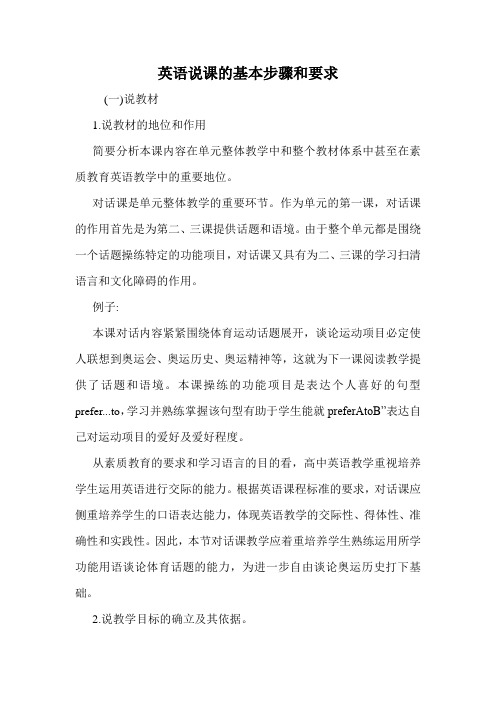
英语说课的基本步骤和要求(一)说教材1.说教材的地位和作用简要分析本课内容在单元整体教学中和整个教材体系中甚至在素质教育英语教学中的重要地位。
对话课是单元整体教学的重要环节。
作为单元的第一课,对话课的作用首先是为第二、三课提供话题和语境。
由于整个单元都是围绕一个话题操练特定的功能项目,对话课又具有为二、三课的学习扫清语言和文化障碍的作用。
例子:本课对话内容紧紧围绕体育运动话题展开,谈论运动项目必定使人联想到奥运会、奥运历史、奥运精神等,这就为下一课阅读教学提供了话题和语境。
本课操练的功能项目是表达个人喜好的句型prefer...to,学习并熟练掌握该句型有助于学生能就preferAtoB”表达自己对运动项目的爱好及爱好程度。
从素质教育的要求和学习语言的目的看,高中英语教学重视培养学生运用英语进行交际的能力。
根据英语课程标准的要求,对话课应侧重培养学生的口语表达能力,体现英语教学的交际性、得体性、准确性和实践性。
因此,本节对话课教学应着重培养学生熟练运用所学功能用语谈论体育话题的能力,为进一步自由谈论奥运历史打下基础。
2.说教学目标的确立及其依据。
1)知识技能(1)学习、掌握关系副词when,where.,why引导的定语从句及介词+关系代词引导的定语从句。
(2)学习掌握一些有关影视的词汇:如:career,director,script,playarolein,Oscar,award,studio,scene,follow-ups 等。
掌握其他一些课文中涉及的词汇:如:graduate,attack,creature,owe…to…,takeoff等。
(3)学习掌握一些用于讨论、评价电影的结构句式:如:What’sthefilmabout?Whatdoyouthinkaboutthestoryofthefilm?Howdoyoufeelaboutthefilm?Ilike/don’tlikethefilmbecause…Thefilmisabout…Ithinktheendingofthefilmis…(4)提高学生语言听、说、读、写的能力及扮演角色、编写剧本、撰写影评等的综合语言运用能力。
英语说课的六个基本环节
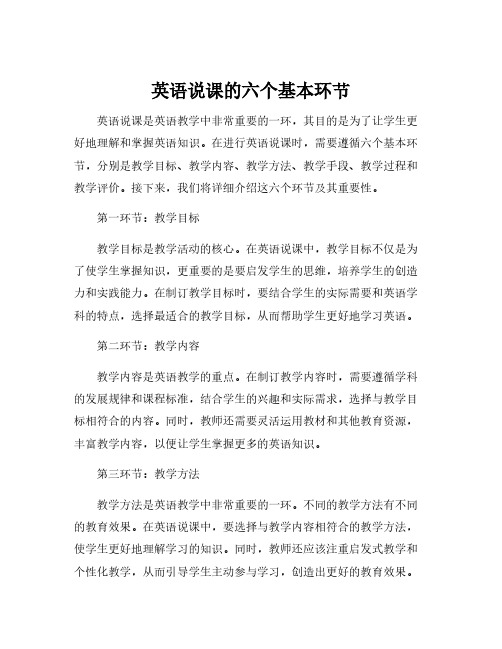
英语说课的六个基本环节英语说课是英语教学中非常重要的一环,其目的是为了让学生更好地理解和掌握英语知识。
在进行英语说课时,需要遵循六个基本环节,分别是教学目标、教学内容、教学方法、教学手段、教学过程和教学评价。
接下来,我们将详细介绍这六个环节及其重要性。
第一环节:教学目标教学目标是教学活动的核心。
在英语说课中,教学目标不仅是为了使学生掌握知识,更重要的是要启发学生的思维,培养学生的创造力和实践能力。
在制订教学目标时,要结合学生的实际需要和英语学科的特点,选择最适合的教学目标,从而帮助学生更好地学习英语。
第二环节:教学内容教学内容是英语教学的重点。
在制订教学内容时,需要遵循学科的发展规律和课程标准,结合学生的兴趣和实际需求,选择与教学目标相符合的内容。
同时,教师还需要灵活运用教材和其他教育资源,丰富教学内容,以便让学生掌握更多的英语知识。
第三环节:教学方法教学方法是英语教学中非常重要的一环。
不同的教学方法有不同的教育效果。
在英语说课中,要选择与教学内容相符合的教学方法,使学生更好地理解学习的知识。
同时,教师还应该注重启发式教学和个性化教学,从而引导学生主动参与学习,创造出更好的教育效果。
第四环节:教学手段教学手段是指在教学过程中,教师用来辅助教学的方法,包括多媒体教学、板书教学、实物教学等。
在英语教学中,教学手段要以学生为中心,注重视觉、听觉、触觉等教学手段的多样性,以便让学生更好地理解和消化所学知识。
第五环节:教学过程教学过程是指在教学中,教师与学生互动,达到教学目标的过程。
在英语说课中,教学过程要重视调整教学节奏和方式,注重启发式引导,引导学生积极参与学习,创造一个良好的教学氛围。
同时,教学过程要注意整个课堂的组织和管理,以确保教学效果。
第六环节:教学评价教学评价是英语教学中重要的一环。
在教学评价时,要根据教学目标和教学内容,选择合适的评价方式和指标,评价教学效果和学生的学习情况,从而不断完善教育教学质量。
英语说课流程的基本步骤

英语说课流程的基本步骤As a teacher, one of the most important skills you need to possess is the ability to deliver a successful teaching demonstration. In the field of English language teaching, this often takes the form of a "lesson demonstration" or "lesson presentation." 作为一名老师,你需要拥有的最重要的技能之一是成功进行教学示范。
在英语教学领域,这通常以"课时演示"或"课程介绍"的形式出现。
When preparing for an English lesson demonstration, it is essential to follow a structured process that will help you effectively convey the key elements of the lesson to your audience. This process typically includes several key steps, such as lesson planning, preparation of materials, and practice delivery. 在准备英语课堂演示时,遵循一个结构化的流程是至关重要的,这将帮助您有效地向观众传达课程的关键要素。
这个过程通常包括几个关键步骤,如课程计划、教材准备和实践交付。
The first step in the process of preparing for an English lesson demonstration is to carefully select the learning objectives for the lesson. These objectives should be clearly defined and measurable, allowing both you and your audience to gauge the success of thelesson. 为英语课程演示做准备的过程中第一步是仔细选择课程的学习目标。
小学英语说课稿的流程
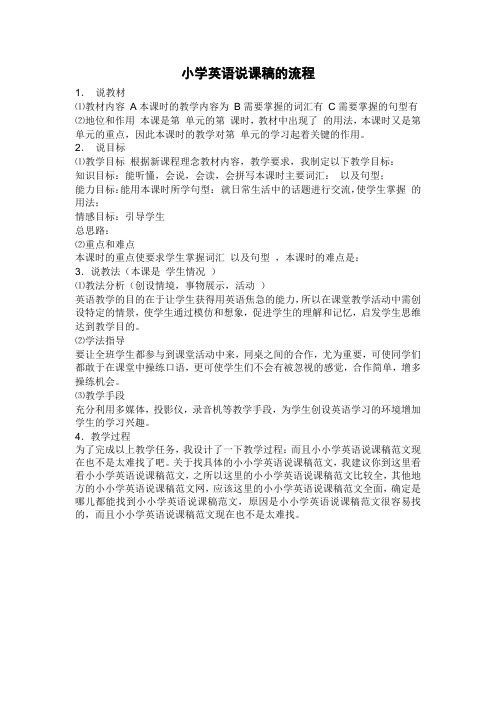
小学英语说课稿的流程
1.说教材
⑴教材内容A本课时的教学内容为B需要掌握的词汇有C需要掌握的句型有
⑵地位和作用本课是第单元的第课时,教材中出现了的用法,本课时又是第单元的重点,因此本课时的教学对第单元的学习起着关键的作用。
2.说目标
⑴教学目标根据新课程理念教材内容,教学要求,我制定以下教学目标:
知识目标:能听懂,会说,会读,会拼写本课时主要词汇:以及句型;
能力目标:能用本课时所学句型:就日常生活中的话题进行交流,使学生掌握的用法;
情感目标:引导学生
总思路:
⑵重点和难点
本课时的重点使要求学生掌握词汇以及句型,本课时的难点是:
3.说教法(本课是学生情况)
⑴教法分析(创设情境,事物展示,活动)
英语教学的目的在于让学生获得用英语焦急的能力,所以在课堂教学活动中需创设特定的情景,使学生通过模仿和想象,促进学生的理解和记忆,启发学生思维达到教学目的。
⑵学法指导
要让全班学生都参与到课堂活动中来,同桌之间的合作,尤为重要,可使同学们都敢于在课堂中操练口语,更可使学生们不会有被忽视的感觉,合作简单,增多操练机会。
⑶教学手段
充分利用多媒体,投影仪,录音机等教学手段,为学生创设英语学习的环境增加学生的学习兴趣。
4.教学过程
为了完成以上教学任务,我设计了一下教学过程:而且小小学英语说课稿范文现在也不是太难找了吧。
关于找具体的小小学英语说课稿范文,我建议你到这里看看小小学英语说课稿范文,之所以这里的小小学英语说课稿范文比较全,其他地方的小小学英语说课稿范文网,应该这里的小小学英语说课稿范文全面,确定是哪儿都能找到小小学英语说课稿范文,原因是小小学英语说课稿范文很容易找的,而且小小学英语说课稿范文现在也不是太难找。
初中英语教师说课流程

初中英语教师说课流程篇一:初中英语说课步骤初中英语说课步骤谓"说课"就是教师在备课的基础上, 依据教学大纲和教材, 在教学理论的指导下, 结合教师, 学生实际和教学条件,向其他教师说明本单元或本节课的教学思想和教学设计.说课,要层次清晰地说明说什么,怎么教,为什么这样教,学生怎么学,以及在教学活动中培养了学生那些方面的能力等.说课的内容包括说教材,说教法,说学法,说教学程序等,说课的模式通常可采用如下的提纲式: 一,说教材 1.教材简析:本说课内容在学科知识体系中所处地位和作用. 2.教学目标:包括知识目标,能力目标和情感目标. 3.教学重点和难点. 二,说教法:教学方法,教学手段,教学媒体的运用三,说学法:学习方法 ,能力培养四,说教学程序 :新课导入,新知识的学习,检测训练,总结巩固,说板书设计具体操作步骤如下: 一,说教材(一) ,依据教学大纲分析教材,分析学生把握教材是设计好每一节课的基础,是教师能够驾驭教学过程取得最佳教学效果的基本前提.因此说课前教师必须钻研教学大纲,领会教材编写意图,分析教材逻辑系统,把握教材知识结构, 并侧重分析本节课内容在教材知识体系中的地位和作用, 分析教材的重点, 难点, 能力点和思想教育点.学生是学习的主体.分析学生是教师实施教学行为的关键,是贯彻因材施教的前提.教师想要在教学过程中让学生增长主体意识,发挥他们的主体作用. (二) ,说明教学目标的确立和实现教学目标的基本思路. 这里所说的教学目标,一般指课时目标.根据教学大纲和教材,学生学习的特点及发展,建立目标体系: (1)确立认知目标:也就是通过学习要使学生在基础知识和基本技能上达到一个什么标准,是掌握还是理解,知道等等. (2)确立能力目标:要求使学生在身心发展上,即能力,情感,意志,性格,体力的发展上达到一个什么标准, (3)确立情感目标: 就是要通过学习培养学生的理想,思想道德,科学世界观和人生观,培养学生的审美观.说课时, 教师要紧紧抓住教学目标, 以充分的理论依据和实践经验说明实现教学目标的基本思路. (三) ,说明突出教学重点,突破教学难点的策略. 教师高超的教学技艺体现在突出重点, 突破难点上, 这是教师在教学活动中投入的精力最大, 付出的劳动最多的方面,教师在说课时,必须有重点地说明突出教学重点,突破教学难点的基本策略. 二,说教法所选用的教学方法要有针对性, 要充分调动学生的积极性. 说课时着重说明其中有独创的做法,特别是培养创新精神和实践能力的具体做法.介绍几种教学法如下: (一) ,激趣法.教学心理学告诉我们,只有学生感兴趣的东西,学生才会积极地开动脑筋认真思考.教师设计的趣味活动要考虑学生的年龄特征,心理特征,学生的接受能力,学生已有的知识储备以及学生的兴趣爱好等等. 比如在学习颜色名称时 ,设计这样问题 yellow+red=?Yellow +blue =? 等问题.既培养学生美术想象能力,又学习了颜色名词.这种学科之间的渗透也往往是学生的兴趣所在. (二) ,创设情境法.人的情感和创造能力总是在一定的情景下产生的.创设真实的生活场景, 在课堂有限的时间和空间范围内, 充分利用教学媒体和生动活泼的教学方法给学生营造一个与生活密切相关的实践语言的环境.如在学习 Unit 2 What should I do ?(Book 2B Go for it! )第一课时, 我采用了两种情景法: 一是给同学提建议解决实际问题, 二是播放歌曲"最近比较烦",让学生帮助歌星解决问题.这两种方法既练习了 target language ,又从学生实际出发, 解决实际问题; 同时借用歌词, 学生了解歌星也是普通人, 他们也有普通人的烦恼, 增强了克服困难的信心. 同时让学生学会运用英语于真实的交际场景中, 激发学生交际的欲望,提高学生学习英语的兴趣. (三) ,直观法.充分利用好教学挂图,实物,手偶,简笔画,动作,多媒体等形象直观, 生动活泼的教学手段,学生通过看图,听音,会意,直接理解英语和提高用英语思维的能力, 从而最大限度地控制和减少汉语的介入,培养良好英语语感习惯,激发学生的创新思维. (四) ,任务型教学法《英语课程标准》明确指出:提倡任务型教学,把综合语言运用能力的培养落实在教学过程中,提倡体验,实践,参与,交流和 1合作方式,实现任务的目标.把学生分成三人或四人小组的学习小组, 让他们围绕着课堂任务分工合作, 在活动中相互探讨, 相互交流, 相互合作, 从而获得知识,技能和情感体验,发展他们的能力. 三,说学法运用灵活多样的学习方法,增强课堂趣味性.培养学生观察力,想象力,记忆力以及思维能力.如通过连贯的听说读写,游戏,竞赛等,培养学生的交际能力,发展他们的思维能力. (一) ,游戏法:游戏是学生最愿意参与的一种活动,能有效地调动学生学习的主动性和积极性,使学生在教学游戏中增长知识,增长智慧.设计游戏的目的主要引导学生在"玩"中学, "趣"中练,"乐"中长才干,"赛"中增勇气. (二) 竞赛法:竞赛法顾名思义就是组织开展各种竞赛活动, , 激励学生大量记忆单词和阅读, 给学生一个自我表现和展示的机会, 由于大多数初中学生都具有争强好胜的心理特征, 因此小组竞赛活动能够督促他们复习和巩固所学知识内容.竞赛法可以用在任何内容的学习上. 比如朗读,表扬,背诵,听写等等.比朗读时可以比谁的发音好;听写时可以比谁书法好; 谁的正确率高;表演时比谁语言运用自如,演技逼真等等.可以让未参与比赛的学生来当评委,有如下优点:一是调动提高他们观看的积极性和认真度,二是教会学生评价审美水平, 三是帮助学生学会公平. (三) ,讨论法:加强课堂讨论,强化学生的竞争意识和创新意识,培养学生提出问题,解决问题的能力.讨论能帮助学生在语言实践中把语言知识和语言技能主动转化为交际能力. 讨论式教学对于学生的智力因素和情感因素的开发和发展都会产生积极的影响. 培养了学生参与合作学习的能力和运用语言进行创新活动的能力. 四,说教学程序说明每一环节所用的大体时间,重点教学双边活动,教学难点和教学重点的突破,理由.教师要说明怎样组织好教学过程,通过导入,新课讲解,反馈练习,归纳总结等控制手段和语言,提问,演示,讲解,板书等基本技能,促进教学过程有序的发展即按规律运动.再者, 还要考虑环节之间的过渡与衔接,使学生更易与接受所学知识. (一) ,新课导入.恰当的导入,能激发学生的学习兴趣,使学生尽快进入状态,并能积极思维, 配合教师在热烈的气氛中进行教学. 我常采用的导入方式有歌曲式导入; 提问式导入; 图片,幻灯等电教手段导入;悬念式导入;游戏式导入;复习式导入等等.有时采用一些与教学紧密相关,并为学生所熟知的材料,能够立刻激发学生学习兴趣和热情.如在学习 Unit 1 Will people have robots?(Book 2B Go for it! )时,我播放《西游记》中孙悟空把毫毛吹成小猴子的片段,然后说:这就是吴承恩所想象到的"克隆".然后再放蔡明郭达合演的有关机器人的小品,问学生:Will people have robots at home in the future?在学生兴趣昂然时自然导入新课,效果非常好. (二) ,新课讲解.阐明教师怎样运用有效的教学方法,充分调动学生的学习积极性,对所讲的内容按怎样的程序进行处理,采取什么方法,手段,生哪些能力,怎样充分暴露学生的思维过程,使教师的任务重在"导"字上,让学生真正参与到教学过程中.如何创造一种宽松的环境,切实让学生充分动手,动口,动脑,做到教师会教,学生会学. (三) ,反馈练习.要阐述练习题的来源,练习题的功能,练习题的操作,练习题的变化. 练习要有目的,难度要适当.所选练习题要体现出层次性,系统性,联系性,针对性. (四) ,归纳总结.要总结哪些内容,其目的是什么,如何总结,如何将本节内容纳入已有的知识系统中,发挥承上启下的作用. (五) ,板书设计.板书设计布局要合理,能反映一堂课的梗概和黑板上所出现的主要内容. (六) ,说明教学效果的预测. 总之,说课要以教材分析和学生状况分析为基础,以教学目标为根本方向,紧紧抓住教学重点和难点,优化教学过程结构,选择教学方法,科学运用各种教学媒体,有效地控制教学过程所要达到的教学效果, 说明其基本的教学思路, 并提出按照教学思路设计的教学实施方案.2Good morning everyone!I'm Nickole. I'm 24. I graduated from Hunan Normal Universaty on Shuda Campus. My major is English Education. After graduation, I have worked for oneyear in Li Yang听Kid's Engish. My students are between 5 and 12years old.I'm outgoing and open-minded. In my spare time, I have broad interests. Such as reading, surfing the internet, listening to music and even chatting with foreign friends online if possible. I like children very much.I think children are active, innocent and pure. With them, I feel very relaxed, plesant and younger. Therefore, I learned a lot from my oneyear working experence.Teaching children English is very interested but it is also challeging. Because children are always active, even sometimes very naughty. So teachers need a lot of patience to deal with children. The most importantthat I have learned from my one year teacing experence is that a teacher should have the kind of听the mind that always wants to go on learning. Teaching is a jobat which one will never be perfet. If I have the chance,I will try my best to be a good primary English teacher.我的八六完善简历面试技巧英文一个好的工程师的简历... 求职信英文范文,20... 中文诸多职位用英文怎... 英语面试常见对话,中... 英语面试对比举例 3面试技巧之如何推销自...求职公司经理英文范文英文简历点金必备好句...面试实战问题:新人如... 画龙点睛:十种经典的... 外企对英文简历都有哪... 没有经验?教你自信满... 男生要注意的面试着装... 女生要注意的面试的着...更多...首页>个人简历模板>英文简历范文英语教师面试时英文自我介绍范文来源:日期:2010-7-8 10:53:45英语老师面试自我介绍的时候应注意些什么?那么你可以从以下几个方面来展开:1.介绍你自己的教育背景;2.介绍你自己的家庭环境背景;3.谈论自己对教师职业的看法;4.谈谈自己作为老师对教学策略的运用;5.谈论自己对教师与学生之间的沟通技巧;6.谈论自己在教学环节当中有什么优势和劣势;7.谈论你应聘本校的动机和理想;8.谈谈你对教育你自己专业与从事教学学科的联系;9.谈谈你自己的个性特征,是否外向,内向,是否有幽默感?10.谈谈你自己的情绪特征,是否精力充沛,有朝气,能够吸引学生?11.谈谈你的人生观;12.谈谈你对人际关系的处理与看法。
英语口语说课教学流程
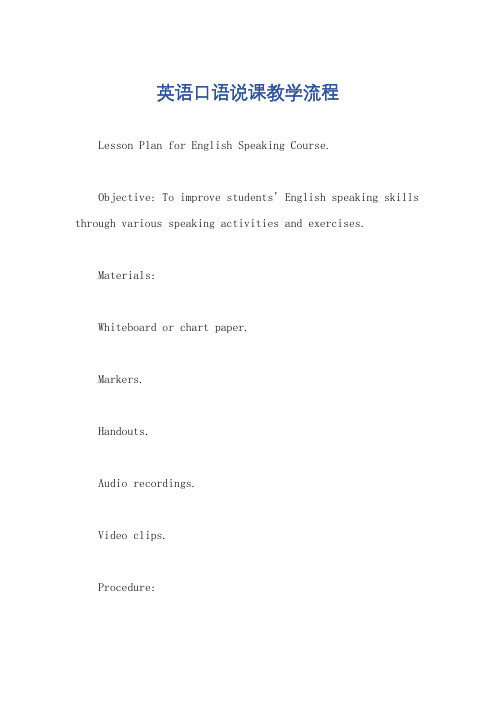
英语口语说课教学流程Lesson Plan for English Speaking Course.Objective: To improve students' English speaking skills through various speaking activities and exercises.Materials:Whiteboard or chart paper.Markers.Handouts.Audio recordings.Video clips.Procedure:1. Warm-up (5 minutes)。
Greet students and make small talk to create a relaxed and friendly atmosphere.Review the previous lesson's topic briefly to refresh students' memory.中文回答,热身 (5 分钟)。
向学生们问好,并进行一些简短的闲聊,以创造一个轻松友好的氛围。
简单回顾一下上一节课的主题,以帮助学生们复习记忆。
2. Vocabulary and Grammar Review (10 minutes)。
Introduce new vocabulary related to the topic of the day.Review grammar points that are relevant to the speaking task.中文回答,词汇和语法复习 (10 分钟)。
介绍与当天主题相关的生词。
复习与口语任务相关的语法要点。
3. Speaking Task (25 minutes)。
Divide students into small groups of 3-4.Assign each group a different speaking topic or task.Provide clear instructions and time limits for the task.Monitor students' performance and provide feedback as needed.中文回答,口语任务 (25 分钟)。
高中英语说课的基本步骤
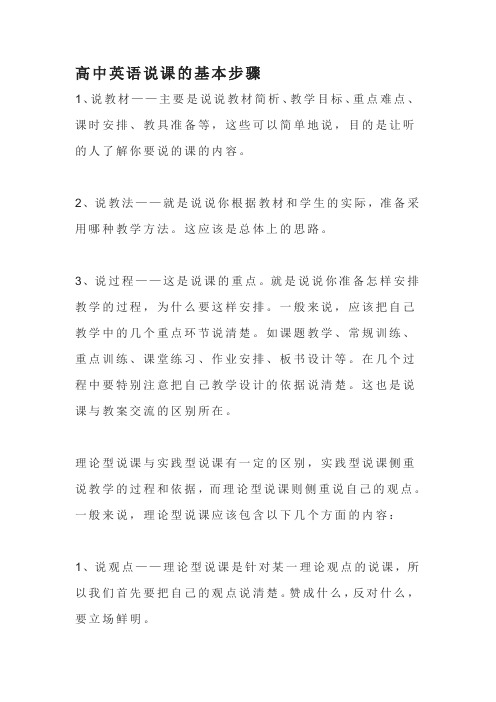
高中英语说课的基本步骤1、说教材——主要是说说教材简析、教学目标、重点难点、课时安排、教具准备等,这些可以简单地说,目的是让听的人了解你要说的课的内容。
2、说教法——就是说说你根据教材和学生的实际,准备采用哪种教学方法。
这应该是总体上的思路。
3、说过程——这是说课的重点。
就是说说你准备怎样安排教学的过程,为什么要这样安排。
一般来说,应该把自己教学中的几个重点环节说清楚。
如课题教学、常规训练、重点训练、课堂练习、作业安排、板书设计等。
在几个过程中要特别注意把自己教学设计的依据说清楚。
这也是说课与教案交流的区别所在。
理论型说课与实践型说课有一定的区别,实践型说课侧重说教学的过程和依据,而理论型说课则侧重说自己的观点。
一般来说,理论型说课应该包含以下几个方面的内容:1、说观点——理论型说课是针对某一理论观点的说课,所以我们首先要把自己的观点说清楚。
赞成什么,反对什么,要立场鲜明。
2、说实例——理论观点是要用实际的事例来证实的。
说课中要引用恰当的、生动的例子来说明自己的观点,这是说课的重点。
3、说作用——说课不是纯粹的理论交流,它注重的是理论与实践的结合。
因此我们要在说课时结合自己的教学实践,把该理论在教学中的作用说清楚。
扩展资料1、简析教材:一般是说科学的一节课,说出这节课在第几册第几章第几节,是什么类型的课(新授课、实验课或复习课等)。
该教材内容在科学中的地位,与前后知识的具体联系以及与相关学科的联系。
该教材的结构特点和教材安排的先后顺序,分析编者选材意图作用。
2、教学目标:教学目标是一堂课的中心任务,所有的教学环节都是为它服务的。
制定目标要符合课程标准和切合学生实际,使学生经过努力能够达到。
科学教学目标包括三维目标,即知识技能、过程与方法和情感态度价值观。
目标的描述要具体、简洁,要有不同层次的要求。
如知识目标层次有:了解、理解、掌握;技能目标层次有:观察、实验、思维等,练习、初步学会、学会;情感目标层次有:兴趣和探索精神、辩证唯物主义、爱国主义,接受、体验、具有。
英语说课稿(共10篇)

英语说课稿(共10篇)英语说课稿(一): 初中英语说课稿精选、说教学程序1.复旧引新阶段.教师和学生进行简单的问候,如:Ss:Good morning,teacher!T:Good morning,class!之后,就上单元的话题和学生展开对话:T:Comrades!We won’t have any lessons this afternoon.I’m going on a field trip.Would youlike to go with meSs:Yes,we do.T:Where are we goingSs:We’re going to the mountains /rivers / hills...T:What do you think we’re going to doSs:We’re going to have a picnic /discuss the air outside...教师可根据当时的情况和学生继续多谈几句,交谈的思维要顺着学生的思维展开.之后,老师问道:T:Do you know what day is tomorrowSs:Yes,we do./No,we don’t.T:Now let me tell you.Tomorrow is Mid-autumn Festival.We’re going to have a big dinner.Would you like to come to my home to eat somethingSs:Yes,we’d love to.到此引出新学课文,教师说:Now let’s learn Lesson9.之后板书“Lesson9”.英语说课稿(二): 新标准初中英语说课稿模板,各位评委X午好!我说课的题目是义务教育课程标准试验教科书《XX》*年级*册第*章确定为本节的重点教学难点:根据(知识**特点、学生已有知识储备或理解能力)确定****为本节难点.根据以上教学目标将详讲***,略讲****,以突出**重点和突破难点二、说教法:根据以上教材分析,为促进学生的**能力发展,对****知识将采用***教法,为落实重点采用**教法;为突破难点采用**教法;等等.(注重启发式、讨论式,实现因材施教)三、说学法:为使所学知识能较好的纳入学生已有的知识体系,促进学生的智能发展,对**知识将分别采用(材料分析法、读图发现法、归纳总结法等等)为落实教学目标将着重做好以下练习:对****知识通过填空、连线、材料、表格、选择、读图等进行训练四、教学过程:1、(创设情景、激发兴趣、复习回顾等),导入新课通过****来(创设情景、激发兴趣、复习回顾等)导出本节课所学知识,板书课题2、(导学结合、图文研习、探究发现等),讲授新课注意:a各步骤清晰流畅b用多媒体时语言是:媒体展示(材料、地图、练习等)c学生活动和教师活动明确,活动说明意图(围绕三维目标)d框题间要有过渡语言e有创新的做法着重说f告诉评委:以上是我的板书设计(条理、知识主干、创新不是简单的知识点排列)3、课堂小结:(回顾小结、指板书小结、媒体展示脉络小结、学生自我小结等),并指出重、难点.4、巩固练习:(此步有无可根据教学过程调节)5、作业设置:以上是我的说课内容(或说课完毕),谢谢各位评委!英语说课稿(三): 求一篇好的,小学英语说课稿Good morning,everyone!Today,I’ll say something about Unit 9 Part A in Book 4 of Oxford English.Background on the reformation of curriculum,this book can connect the life and act,emphasize the interest and experience of the Ss,the pictures are active and vivid.Grade four is the initial stage of English learning,so it stresses on the emotion of the Ss,creates a well beginning for the Ss.This Unit has 7 parts,we’ll learn Part A mainly,it embodies the repeating characterize.Review the learned language points “Where’s…”and the new language points will be represented in the following units.So this unit forms connectinglinks with a special meaning in this book.The content of thi s period is to use “Where’s\are…” to determine the place.And according to the contents and the fact of the Ss,I establish the following three teaching aims of this period:The first one:students can listen,read,say and spell the following words:a glass,a fridge,an egg,bread and a table.The second one:students can listen,read,say and write the following daily expressions:What’s for breakfastHave some juice then.The third one:students can listen,read,say and write the following sentence pattern s:Where’s\Where are the\my…It’s \They’re…There’s no …in \on \near…I think the most difficult point of this period is to make sure the students can use the patterns “Where’s\Where are…and There isno …in\on\near…” in their daily life correctly.And I will use some pictures,words and sentence cards,a tape recorder and the multi-media computer to help me achieve the aims. The task-based method,communicated method,group cooperate method will be used in this period.To accomplish the aims,I design the following steps:Step 1 Songs and the game arousers the emotion.In order to attract the Ss’ attention and construct an atmosphere of learning English,I let the students sing some English songs and play the game “Simon says”.At the same ti me the game can review the prep,serve the knowledge as foil and consist the appearance of the knowledge.Step 2 Change class to life,happy to say.The substance of language is communication and the environment of communication is life.So when I present the sentence pattern “What’s for breakfast” I first show a clock to elicit the time for breakfast,teach the sentence.Then show my own photo of having breakfast,Ss ask and guess.In this way I can attract Ss’attention,encourage Ss to ask Qs with the new knowledge.Most of the Ss have learnt the sentence pattern:Where’s…so I design a task for Ss to help Helen find the food and drinks forbreakfast,and teach the new language points:Where are…They’re … Meanwhile stick the sentences on the Bb.After some practice by asking and answering,I present the next language points:There’s no …in\on\near…Have …then.And I will stick these sentence patterns on the Bb.Finally I’lllet the Ss do pair works to consolidate them.Step 3 Listen to the tape and Ss imitate to read and say.As the new reformation of curriculum,emphasized the traditional class attach importance to the mechanical teaching,neglect the experience and participation,for example,the five-step method.So in this lesson,after presentation,I ask Ss to listen to the tape with three Qs,read in different roles and in pairs,then try to recite the text.Step 4 Ss be the main body,T makes a guider.In class,Ss play as a host,and the T makes an influence on guiding,help Ss to act the learnt dialogue,it can stress the position of the Ss,and arouse their interest.Then I show a carton with no voice,ask Ss to make a dialogue in pairs.There are lots of ways to consolidate the new knowledge.Playing game is a good way.So according to the physiology of Ss,I hold a group competition during the game,ask Ss to finish the blanks.In this way can develop Ss’ good habits and achieve the aim of mastering the learned knowledge in situation.Step 5 Change class to life,learn by themselves.Is t his the end of the classI don’t think so.If there is an end,Ithink it should be in the life.So I extend this class,encourage Ss to use the learned to communicate with each other in their life.In a word,the whole period is based on tasks,which are designed from easy steps to steps that are challenging.When the Ss are carting out the tasks,they can acquire information,knowledge,and have their ability and skills trained.That’s all.Thanks a lot for your attention.英语说课稿(四): 英语教师如何撰写说课稿所谓说课,是指在某一特定的场合,教师较为系统地讲述某一教学内容的课堂教学设计及其设计的理论依据.说课分详细说课和概略说课.一、英语说课讲稿的要素及撰写方法英语说课讲稿也包括五个要素:说教材、说教法、说学法、说教学程序、说板书设计.(一)说教材说教材要对教材所在的知识系统做简要分析,通过分析某课教学内容在整个教材体系中的作用,以及本课教学内容与学生先前掌握的知识和将要学习的知识的联系,说明教材的地位和作用;通过对课程标准关于教学的具体要求的概括分析,说明本课教学目标的确立及其依据;通过对英汉两种语言差异和学生的知识水平的简要分析,确定并说明重点、难点和关键点的确立及其依据.1.说教材的地位和作用.说教材的地位和作用,应简要分析本课内容在单元整体教学中和整个教材体系中甚至在素质教育英语教学中的重要地位.例如,在分析SEFC Bl L37的教材地位和作用时可做如下表述.SEFC Bl L37是对话课,对话课是单元整体教学的重要环节.作为单元的第一课,对话课的作用首先是为第二、三课提供话题和语境.由于整个单元都是围绕一个话题操练特定的功能项目,对话课又具有为二、三课的学习扫清语言和文化障碍的作用.本课对话内容紧紧围绕体育运动话题展开,谈论运动项目必定使人联想到奥运会、奥运历史、奥运精神等,这就为下一课阅读教学提供了话题和语境.本课操练的功能项目是表达个人喜好的句型"prefer...to",学习并熟练掌握该句型有助于学生能就"prefer A to B”表达自己对运动项目的爱好及爱好程度.从素质教育的要求和学习语言的目的看,高中英语教学重视培养学生运用英语进行交际的能力.根据英语课程标准的要求,对话课应侧重培养学生的口语表达能力,体现英语教学的交际性、得体性、准确性和实践性.因此,本节对话课教学应着重培养学生熟练运用所学功能用语谈论体育话题的能力,为进一步自由谈论奥运历史打下基础.2.说教学目标的确立及其依据.教学目标的确立首先要根据单元教学的目的和要求(对语音、词汇、日常交际用语、语法等方面的不同程度的要求),结合学生的实际水平,确定贯穿单元教学的总目标(goal).总目标可以是相当概括的,如SEFC Bl L37的总体教学目标可定为“了解奥运会历史,学习表达个人爱好的交际用语".一节课的教学目标(objective)则应落实到与本课教学内容相关的具体语言知识或某项技能上,即:通过本节课的教学,重点解决什么问题(知识和能力),达到什么样的要求.为了贯彻“寓思想教育于语言教学之中"的教学原则,教师还要深入挖掘教材的德育因素,从而确定德育(情感情意)目标.教学目标的表述要准确、具体、简洁、全面,要明确写出本节课的知识目标、能力目标和德育目标.如,JEFC B3 L82的教学目标可表述如下.(1)知识目标:学习和掌握过去完成时;总结和归纳有关购物用语;复习衣服的名称、颜色、大小等词汇.(2)能力目标:通过听录音,掌握正确的语音、语调,使学生形成良好的语言习惯;通过学生间的提问和回答,激发学生学习的积极性和主动性;同时在阅读过程中,注意发展学生的逻辑思维能力.(3)德育目标:通过购物的学习和问答,使学生注意和学习在交际中的礼貌行为(寓思想教育于语言教学之中).3.说重点、难点和关键点的确立及其依据.说课稿要写出该课的重点、难点和关键点分别是什么,并写出确立该重点、难点和关键点的理论依据,即在列举该课重点、难点和关键点的同时,说明为什么该重点是本课教学的最主要部分或最重要内容,为什么该难点在本课教学中是学生最难理解和最容易出现错误的部分(有时重点和难点相同),为什么该关键点对本课教学的成败起决定性的作用.例如,JEFC B3 L2l说重点、难点、关键点及其依据可表述如下.(二)说教法说教法至少要说明选择使用何种教学方法,以哪种教学方法为主,哪几种方法为辅,采用什么教学手段实现教学目标,采用这些教学方法和手段的理论依据是什么,并说明这些教学方法在本课教学中的具体操作方法.说教法时最好能说明在本课教学过程中贯彻什么教学原则,采用什么教学模式,并做出必要的解释和说明.如果巳形成了独特的教学思想和教学特色,最好单独列出.例如,SEFC Bl L37的说教法可表述如下.英语说课稿(五): 英语说课的基本步骤【英语说课稿】本课的总体思路(目标、要点、巩固)如何开始这堂课如何进入这堂课如何让学生学以致用如何总结英语说课稿(六): 求初中英语语法说课稿-全英文版Good afternoon, everyone. I’m Zhou Yan. I’m an English teacher from Experimental School of Suqian. Now I’ll say Sample A of Lesson Six in Book One. I’ll prepare to say the lesson from four parts. Part One Analysis of the Teaching Material(一) STATUS AND FUNCTION1.This is an important lesson in Book One. From this lesson, it starts asking the Ss to grasp contents of each Sample. To attain “four skills” request of listening, speaking, reading and writing. To start listing “Word Bank” and tell the Ss to remember the new words. To start asking the Ss to write English sentences well. Therefore this lesson is in the important position of the teaching material.2.This lesson is the first one of Unit 2.So if the Ss can learn it well, it will be helpful to make the Ss learn the rest of this unit.3.Such a topic is related to daily life, so it is helpful to raise learning interests of students and it will be also helpful to improve their spoken English.(二)ANALYSIS OF THE STUDENTSThe Ss has learned English for about one month so far. They can understand some words and some simple sentences. The Ss have taken a great interest in English now.(三)TEACHING AIMS AND DEMANDSThe teaching aim"s basis is established according to Junior School English syllabus" provision.1.Knowledge objects(1) To make the Ss know how to use the affirmative sentence “Th is is. . . .” and the negative sentence “This is not….”Everyday expressions for “Apologies”“I\"m sorry”“That\"s all right”. (2) To study the new words “six, hey, sorry, it’s, that’s”, etc. by learning the dialogue of this lesson.(3) To finish some exercises.2.Ability objects(1) To develop the Ss’ abilities of listening, speaking, reading and writing.(2) To train the Ss’ ability of working in pairs.(3) To develop the Ss’ abilities of communication by learning the useful structures.3.Moral objects(1) To enable the Ss to be polite and love life.(2) To enable the Ss to look after their things well.(四)TEACHING KEY AND DIFFICULT POINTSThe teaching key and difficult points’ basis is established according to Sample A of Lesson Six in the teaching material\"s position and function.1.Key points:(1).To help the Ss to communicate with each other.(2).To enable the Ss to study in groups and co-operate skillfully.(3).To develop the Ss’ interest in Eng lish.2.Difficult points:(1) How to make dialogues and act them out.(2) How to write the right whole sentences.(五) TEACHING AIDSMulti-media computer, Tape recorder, Software: Powerpoint or Authorware, school things and so on. They will be needed in this lesson.Part Two The Teaching Methods1. Communicative teaching method2. Audio-visual teaching method3. Task-based” teaching methodAs we all know: the main instructional aims of learning English inthe Middle Sc hool is to cultivate students’ abilities of listening, speaking, reading, writing and their good sense of the English language. So in this lesson I’ll mainly use “Communicative” teaching method, “Audio-visual” teaching method and “Task-based” teaching meth od. That is to say, I’ll let the Ss to get a better understanding of the key structure of the dialogue. I’ll give the Ss some tasks and arrange five kinds of activities: talking, guessing games, watching CAI, acting out Sample A and having a competition. Teaching special featuresTo use these methods are helpful to develop the Ss’ thought.Part Three STUDYING WAYS1.Teach the Ss how to be successful language learners.2.Let the Ss pass \"Observation—Imitation—Practice \" to study language.3.Teach the Ss how to master dialogues and how to communicate with others.Teaching special features:Let the Ss communicate with each other and adopt competition methods to develop the Ss’ keen interest in English.Part Four Teaching ProcedureI’ll finish this lesson in four steps. First I’ll divide the Ss into four groups and bring a competition into the class. At lastlet’s see which group is the winner.Step1 Warm-up1. Free talk between T and Ss .Such as: Hi, I’m . .. . What’s your nameThis is …. How do you doWho is he/she How are youWho can count from 1to 5What’s this in English etc.2.A game: Ask the Ss to give T some school things. For example: T: Give me your book.(ruler, box, pen, table, knife, etc.)T: This is your book. This is not my book. It’s your book. etc. In this course I’ll ask them to make a dialogue group by group without repetition. Find out which group will make the most dialogues.Purpose of my designing: I think it is important to form a better English learning surrounding for the Ss by imitating and at the same time it is necessary to provide situations to review learned knowledge.Step2. PresentationThis course is very important. I’ll mainly talk ab out this step. I’ll use CAI to present the whole dialogue. Arrange somesituations to help Ss understand Sample A.First scene: There is a bag on the floor. B is picking it up and get ready to leave. Now A is talking with B.A: Hi, B. How are you todayB: I’m fine, thank you. And youA: I’m fine, too. Oh, this is my bag.B: No, this is not your bag. It’s my bag.A: (Look closely) Oh, I’m sorry.B: That’s all right.(At the same time, C is running up and hitting A.)C: Oh, I’m sorry.A: That’s OK.I’ll write the key points on the Bb while they are watching. Afterwatching, I’ll teach them to read the words and sentences on the Bb. Make sure they can read them well.Purpose of my designing: To present Sample A by CAI is much easier for the Ss to learn and grasp the meanings. CAI can provide a real situation with its sound and picture and it makes the relationships between the Ss better.Step3.PracticeFirst play the tape recorder. Let the Ss listen and imitate the dialogue. Pay attention to their pronunciation and intonation. Inthis step the Ss are required to practise the Sample in pairs by reading the dialogue aloud. This step is employed to make the Ssgrasp the Sample .At last I’ll ask the Ss to th ink hard and act it out with a partner according to Sample A. Then find out which group will act it out well. I’ll give them red stars.Purpose of my designing: This step is employed to make the Ss get the general idea of the dialogue as a whole one. At the same time let the Ss have a chance to practise their listening and spoken ability. Step4.ProductionIn this step I’ll give the Ss a free space to show theirabilities.Second scene: The Ss are having a picnic. It’s hot and they takeoff their coats and put them together. They are singing and dancing, laughing and chatting. After the picnic, they begin to look for their coats. D and E are talking. F and G are talking. etc.After watching, I’ll give the Ss some tasks to make similar dialogues without repetition and find out which group will make more dialogues.Purpose of my designing: “Task-based” teaching method is usedhere to develop the Ss’ ability of communication and also their ability of co-operation will be well trained. Tell the Ss we should be polite and take good care of our things. We should love our life.I think proper competition can arouse the Ss’ interest in English learning. If the Ss can finish this task well, they will benefit alot in their spoken English.2.Skill 1 Model 1.I’ll ask four Ss of the groups to write these sentences on the Bb in the four lines.Then check their handwriting, correct their mistakes. Find out who will write well and whose handing is the best.3.Finish the Ss’ workbook.Purpose of my designing: To check the knowledge Ss have learned in this lesson.Step5.Homework:(1)Recite the words as many as possible after class.(2)Make a dialogue according to Sample A and write it in the exercise book.Purpose of my designing: I think homework is so important that the Ss should speak English as much as they can in class or after class. It is necessary for the Ss to do some extensive exercises after class to consolidate the knowledge they learned.Blackboard DesignLesson Six Sample ASix This is my….hey This is notyour. . . .sorry It’s my. . . . Picture it’s=it is Oh, I’msorry.that’s=that is That’s all right/OK.【英语说课稿】英语说课稿(七): 高一英语说课稿是要全英文的还是中文的最好是中英文穿插在一起的全英文学生会跟你没什么互动全中文的听课的老师和学生可能又会觉得你水平有限英语说课稿(八): 求一两篇小学英语试讲稿和说课稿My FamilyI have a happy family . I am the only child in my family.My father is thirty-two years old. He is 170cm in height. He is a farmer and he often works hard in the field from morning till night. When my father is free , he will go to find another job to make more money. My mother is a housewife . She does housework every day.I am a sunny girl . My name is He Hua. I like growing flowers andI look after them with my parents .I love my family.英语说课稿(九): >>[转]怎样写小学英语说课稿(全英文的)它是整个模块的重点,占有很重要的地位,它为后两个单元的学习奠定了基础.2.教学目标知识目标:学习掌握单词 football. basketball. table tennis. morning exercise,学习运用句型I like …\I don"t like ….能力目标:培养学生运用英语的能力.德育目标:教育学生热爱体育运动,勤于体育锻炼.确立教学目标的依据:根据《英语新课程标准》的要求,小学阶段的英语课主要是激发学生学习英语的兴趣;培养学生对英语学习的积极态度,使他们建立学习英语的自信心;培养学生一定的语感和良好的语音、语调,为英语的进一步学习打下基础.3.教学的重点与难点教学重点:能听说单词 football. basketball. table tennis. morningexercise,运用句型I like …\I don"t like ….教学难点:灵活运用句型I like …\I don"t like ….确立教学重难点的依据:根据《英语新课程标准》的要求以及本课在教材中所处的地位和作用.英语说课稿(十): 英文说课的步骤需要说哪几大块我是去参加英语说课比赛,是求职面试用的吧.学校会先给定说课的范围,给10分钟左右的准备时间.说课其实就是讲讲你如何将给定的文章展开来讲给学生听,所以突出的是你的讲课的构想和思路,而不是具体的语法点等等的内容.说课一般是精读课文,所以可以从突出以下几部分来讲:1.文章的创作背景,作者简介;突出文章时代特点(以提问回答的方式.)2.文章主要涉及的语法现象(以归纳总结的方式.)3.文章的主要词汇(以举例的方式)4.课堂总结5.课后作业因为说课说的是一堂课的安排,所以预习、学习、练习、复习、作业各个部分要完整.说课是把听众定位为老师、评委;讲课是把听众定位为学生.但是现在一般学校面试的时候不是特别区分讲课和说课的,通常情况下是连说带讲的.而且还会有提问回答的环节,问题内容可能会涉及自己的研究领域、论文、兴趣所在等等的.所以不能轻视啊!加油,初中英语说课稿小学英语说课稿。
英语说课步骤及示范课

英语说课步骤及示范课一、说课步骤1、课前准备在上课前,我进行了充分的准备,包括对课程内容的熟悉、对教学目标的理解和对教学方法的选择。
我认真阅读了教材,研究了学生,制定了教学计划,为说课做好了充分的准备。
2、导入新课在导入新课时,我采用了提问和展示图片的方法,引导学生思考并回答问题。
通过这种方式,我激发了学生的学习兴趣和好奇心,为接下来的教学打下了良好的基础。
3、讲解新知识在讲解新知识时,我采用了直观教学和情境教学的方法。
我利用图片、实物和动作等手段帮助学生理解新知识,并设置了情境,让学生在情境中学习和运用语言。
同时,我还注重培养学生的口语和听力能力,通过朗读、对话和听力练习等方式,让学生多听多说。
4、巩固练习在巩固练习时,我采用了多种形式,包括对话、听力和写作等。
我通过这些练习,帮助学生巩固新知识,提高他们的语言运用能力。
5、归纳小结在归纳小结时,我引导学生回顾本节课学到的知识,并总结重点和难点。
同时,我还鼓励学生提出自己的问题和建议,以便更好地帮助他们掌握新知识。
二、示范课下面是一节英语说课的示范课:课题:Unit 7 The Weather (Book 1)教学目标:1、让学生掌握有关天气的词汇和句型;2、培养学生的听说读写能力;3、引导学生了解不同地区的天气情况,培养他们的跨文化意识。
教学重点:掌握有关天气的词汇和句型。
教学难点:正确使用不同句型表达天气情况。
教学方法:直观教学、情境教学、任务型教学等。
教学步骤:1、导入新课:通过展示一些不同天气的图片和播放一些天气预报的视频,引导学生思考和回答与天气相关的问题。
2、讲解新课:通过展示图片、实物和动作等手段,帮助学生理解有关天气的词汇和句型。
同时设置情境,让学生在情境中学习和运用语言。
3、巩固练习:通过对话、听力和写作等练习,帮助学生巩固新知识,提高他们的语言运用能力。
4、归纳小结:通过引导学生回顾本节课学到的知识,并总结重点和难点。
同时鼓励学生提出自己的问题和建议。
英语口语说课教学流程
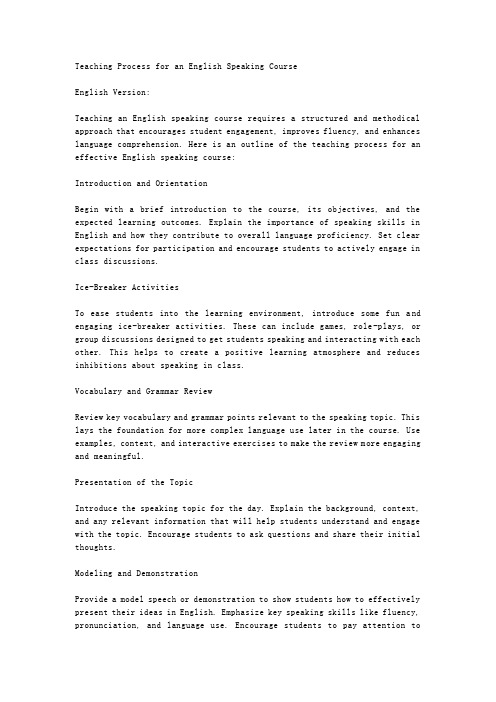
Teaching Process for an English Speaking CourseEnglish Version:Teaching an English speaking course requires a structured and methodical approach that encourages student engagement, improves fluency, and enhances language comprehension. Here is an outline of the teaching process for an effective English speaking course:Introduction and OrientationBegin with a brief introduction to the course, its objectives, and the expected learning outcomes. Explain the importance of speaking skills in English and how they contribute to overall language proficiency. Set clear expectations for participation and encourage students to actively engage in class discussions.Ice-Breaker ActivitiesTo ease students into the learning environment, introduce some fun a nd engaging ice-breaker activities. These can include games, role-plays, or group discussions designed to get students speaking and interacting with each other. This helps to create a positive learning atmosphere and reduces inhibitions about speaking in class.Vocabulary and Grammar ReviewReview key vocabulary and grammar points relevant to the speaking topic. This lays the foundation for more complex language use later in the course. Use examples, context, and interactive exercises to make the review m ore engaging and meaningful.Presentation of the TopicIntroduce the speaking topic for the day. Explain the background, context, and any relevant information that will help students understand and engage with the topic. Encourage students to ask questions and share their initial thoughts.Modeling and DemonstrationProvide a model speech or demonstration to show students how to effectively present their ideas in English. Emphasize key speaking skills like fluency, pronunciation, and language use. Encourage students to pay attention tonon-verbal communication like eye contact and body language.Pair and Group WorkDivide students into pairs or small groups and assign speaking tasks related to the topic. This allows students to practice speaking in a c ontrolled environment and receive feedback from their peers. Encourage students to use the vocabulary and grammar reviewed earlier.Class DiscussionFacilitate a class discussion where students share their ideas and experiences related to the topic. Encourage active listening and respectful disagreement. Provide feedback and suggestions on language use and speaking skills.Summary and HomeworkWrap up the lesson by summarizing the key points and highlighting any important language or concepts. Assign homework that reinforces the speaking skills learned in class, such as practice speeches, role-plays, or online discussions. Encourage students to continue practicing their speaking skills outside of class.Ongoing Assessment and FeedbackRegularly assess students' speaking skills throughout the course and provide feedback on their progress. Use a variety of assessment tools like speaking tests, class participation, and peer reviews to get a comprehensive understanding of students' language proficiency. Provide constructive feedback that helps students identify areas for improvement.Course Evaluation and ConclusionAt the end of the course, conduct a formal evaluation to assess students' overall speaking proficiency. Use a variety of evaluation methods like final exams, portfolios, or presentations to capture students' progress. Provide a concluding lesson that summarizes the key learnings from the course and encourages students to continue developing their speaking skills.By following this structured teaching process, English speaking courses can be effective in improving students' language proficiency and confidence in speaking English.英语口语说课教学流程中文版:英语口语说课的教学流程需要结构化和系统化,以鼓励学生参与、提高口语流利性和增强语言理解力。
英语说课流程的基本步骤
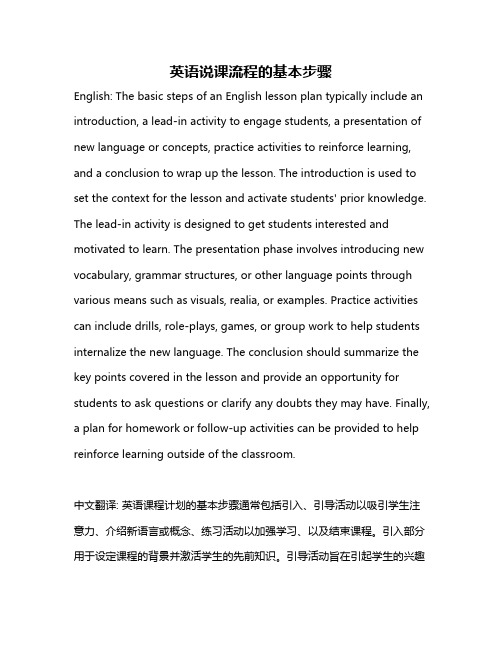
英语说课流程的基本步骤English: The basic steps of an English lesson plan typically include an introduction, a lead-in activity to engage students, a presentation of new language or concepts, practice activities to reinforce learning, and a conclusion to wrap up the lesson. The introduction is used to set the context for the lesson and activate students' prior knowledge. The lead-in activity is designed to get students interested and motivated to learn. The presentation phase involves introducing new vocabulary, grammar structures, or other language points through various means such as visuals, realia, or examples. Practice activities can include drills, role-plays, games, or group work to help students internalize the new language. The conclusion should summarize the key points covered in the lesson and provide an opportunity for students to ask questions or clarify any doubts they may have. Finally, a plan for homework or follow-up activities can be provided to help reinforce learning outside of the classroom.中文翻译: 英语课程计划的基本步骤通常包括引入、引导活动以吸引学生注意力、介绍新语言或概念、练习活动以加强学习、以及结束课程。
小学英语说课流程

小学英语说课流程.我说课的内容是_______教材______课时。
这是一节______课,围绕_______展开。
本课时的教学内容为____________根据这一安排和学生的整体认识水平,从知识教学、能力培养等方面考虑,我确立本课时的教学目标为:1、能听懂会说2、听懂会说3、能运用所学句型进行对话表演和口语交际,激发学生学习英语的兴趣,培养学生的英语学习能力。
本课时的教学重点是:教学难点是:为实现以上目标,我是这样设计教学过程的:一、warming up(通过唱唱、问答的形式,不仅吸引学生的注意力,调动积极性,而且营造了学习英语的氛围。
同时也为本课的教学作了知识的铺垫,构建了知识表象。
)二、revision(以对话的形式,唤起学生的记忆,使学生熟练运用旧知,同时对i’m hungry进行了渗透。
)三、presentation(利用旧知,在已熟练了的交际语境中学习新单词,同时配以相应的图片,加深了对单词的理解,也降低了难度。
并即使由师生操练转向生生操练,由模仿提高到运用,这符合学生的认知规律。
)(将单词融进有实际意义的对话中,充分体现在交际中教,在运用中学的理念,通过这种方式便于学生的理解和运用。
)(在说的过程中予以图片加以配合,帮助理解;由模仿到练习,反复刺激学生的感官,增强学生对新知的理解和运用。
)四、practise1、listen to the tape and read after the tape.2、act out the dialogue.(在听读的过程中培养学生良好的学习习惯,通过演演的形式让学生在情景中练习达到掌握的目的。
)五、consolidation1、make a survey.2、who’s the best?(师生示范表演为学生提供一个可操作的模式,以任务型的活动方式,通过合作学习,并予以评价知道,给学生提供平等的说英语的机会,鼓励学生在竞赛中学,这样既创造了轻松愉快、自然和谐的课堂气氛,又促进了交际活动的展开。
英语说课流程的基本步骤
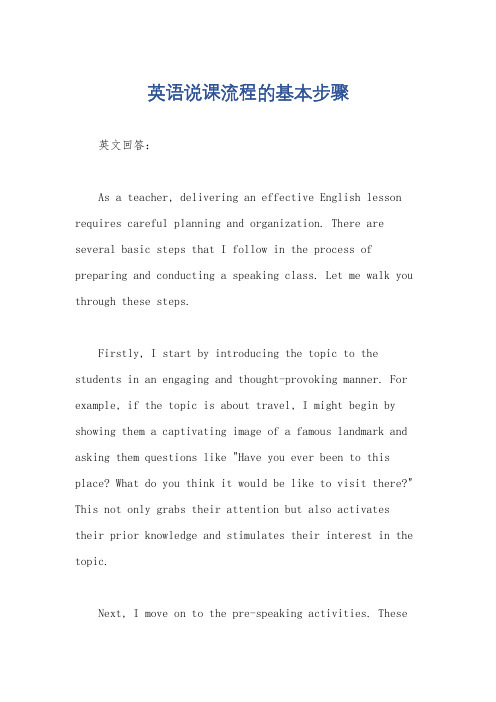
英语说课流程的基本步骤英文回答:As a teacher, delivering an effective English lesson requires careful planning and organization. There are several basic steps that I follow in the process of preparing and conducting a speaking class. Let me walk you through these steps.Firstly, I start by introducing the topic to the students in an engaging and thought-provoking manner. For example, if the topic is about travel, I might begin by showing them a captivating image of a famous landmark and asking them questions like "Have you ever been to this place? What do you think it would be like to visit there?" This not only grabs their attention but also activates their prior knowledge and stimulates their interest in the topic.Next, I move on to the pre-speaking activities. Theseactivities are designed to help students build up their vocabulary and language skills related to the topic. For instance, I might give them a set of travel-related words and ask them to group them into categories such as modes of transportation, types of accommodation, and popular tourist attractions. This not only expands their vocabulary but also encourages them to think critically and categorize information.After the pre-speaking activities, it's time for the main speaking task. This is where students get the opportunity to practice their speaking skills and express their ideas on the topic. To make this task moreinteractive and engaging, I often use pair or group work. For example, I might ask students to work in pairs and discuss their dream travel destinations, using the vocabulary and phrases they have learned earlier. This not only encourages collaboration and peer interaction but also provides a comfortable and supportive environment for students to practice their speaking skills.Following the main speaking task, I move on to thepost-speaking activities. These activities are aimed at reinforcing what students have learned and giving them feedback on their performance. For instance, I might ask students to write a short reflection on their speaking experience, highlighting the challenges they faced and the strategies they used to overcome them. This not only encourages self-reflection but also helps them identify areas for improvement and develop their speaking skills further.In addition to these steps, I also incorporate various teaching aids and resources to enhance the learning experience. For example, I might use authentic materials such as travel brochures or videos to provide real-life context and make the lesson more engaging. I also make use of technology, such as interactive whiteboards or online resources, to incorporate multimedia elements into the lesson and cater to different learning styles.Overall, the process of delivering an English lesson involves introducing the topic, engaging in pre-speaking activities, conducting the main speaking task, andconcluding with post-speaking activities. By following these steps and incorporating various teaching aids, I aim to create a dynamic and interactive learning environment that promotes effective communication and language development.中文回答:作为一名教师,进行有效的英语课程需要仔细的计划和组织。
英语说课的基本步骤

英语说课的基本步骤英语说课是指教师在教学实践中,通过口头表达的方式,向观摩者介绍自己将要开展的一节英语课程。
下面是英语说课的基本步骤:1. 开场白:在开始说课之前,教师应该先向观摩者打招呼并介绍自己,包括姓名、教龄、所任教的学校和班级等信息。
同时,简要介绍一下即将进行的课程的主题和内容。
2. 教材分析:教师需要对教材进行分析,包括教材的背景、教学目标、教学内容、教学重点和难点等。
同时,还要解释教材与课程整体目标的关联性,并提出自己的教学目标。
3. 教学设计:教师需要详细说明教学过程中的各个环节,包括引入新课、呈现新知、练习与巩固、拓展与应用等。
在每个环节中,教师需要说明所选用的教学方法、教学手段和教学资源,并解释其合理性和有效性。
4. 教学重点和难点:教师需要明确指出本节课的教学重点和难点,以及如何通过合理的教学设计和教学方法来解决这些难点。
同时,还要说明学生可能面临的困惑和解决办法。
5. 板书设计:教师需要展示自己准备的板书内容,包括标题、关键词、例句等。
同时,还要解释板书的布局和使用方法,以及板书与教学内容的对应关系。
6. 教学评价:教师需要说明如何进行教学评价,包括形成性评价和终结性评价。
形成性评价可以通过课堂观察、口头回答问题、小组活动等方式进行;终结性评价可以通过作业、测验等方式进行。
同时,还要解释评价的目的和意义,以及如何利用评价结果进行教学反思和调整。
7. 教学反思:教师需要对自己的教学设计和教学实施进行反思,包括教学效果、教学方法的有效性、学生的反应等。
同时,还要提出自己对今后教学的改进意见和建议。
8. 结束语:在结束说课之前,教师可以总结一下本节课的主要内容,并再次强调教学目标和教学重点。
同时,还要感谢观摩者的聆听和关注,并表示愿意接受他们的意见和建议。
以上是英语说课的基本步骤,教师可以根据自己的实际情况进行适当调整和补充。
通过说课,教师可以向观摩者展示自己的教学设计和教学思路,同时也可以提升自己的教学能力和专业水平。
初中英语说课稿的基本步骤六步
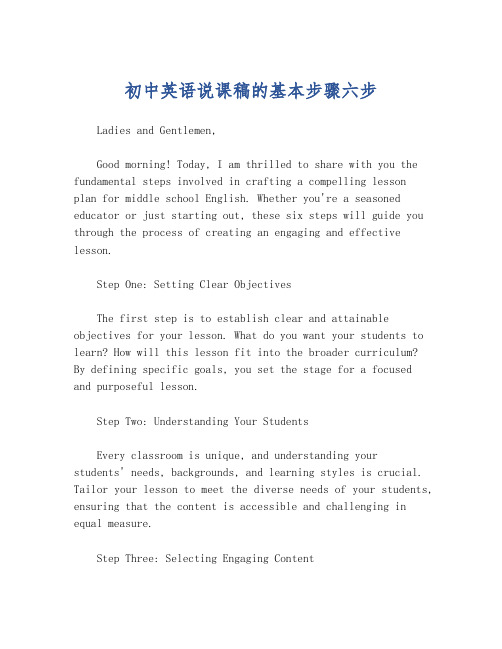
初中英语说课稿的基本步骤六步Ladies and Gentlemen,Good morning! Today, I am thrilled to share with you the fundamental steps involved in crafting a compelling lessonplan for middle school English. Whether you're a seasoned educator or just starting out, these six steps will guide you through the process of creating an engaging and effective lesson.Step One: Setting Clear ObjectivesThe first step is to establish clear and attainable objectives for your lesson. What do you want your students to learn? How will this lesson fit into the broader curriculum? By defining specific goals, you set the stage for a focused and purposeful lesson.Step Two: Understanding Your StudentsEvery classroom is unique, and understanding yourstudents' needs, backgrounds, and learning styles is crucial. Tailor your lesson to meet the diverse needs of your students, ensuring that the content is accessible and challenging in equal measure.Step Three: Selecting Engaging ContentContent is the heart of any lesson. Choose materials that are not only relevant to your objectives but also captivating. Engaging content can transform a mundane lesson into an unforgettable experience.Step Four: Designing Interactive ActivitiesInteractive activities are the key to student engagement. Design activities that encourage participation, collaboration, and critical thinking. Whether it's a group discussion, arole-play, or a creative writing exercise, make sure every student has the opportunity to actively engage with the material.Step Five: Incorporating AssessmentAssessment is not just about testing; it's about understanding how well your students have grasped the material. Incorporate formative assessments that providereal-time feedback, allowing you to adjust your teaching approach as needed.Step Six: Reflection and RevisionThe final step is to reflect on the lesson. What worked well? What could be improved? Use this reflection to revise and refine your lesson plan for future use. Remember,teaching is a dynamic process, and continuous improvement isat the core of effective pedagogy.In conclusion, these six steps form the backbone of awell-structured middle school English lesson plan. By focusing on objectives, understanding your students,selecting engaging content, designing interactive activities, incorporating assessment, and reflecting on the lesson, you can create a learning environment that is both challenging and inspiring.Thank you for your attention, and I look forward to any questions you may have.。
说课稿英语流程
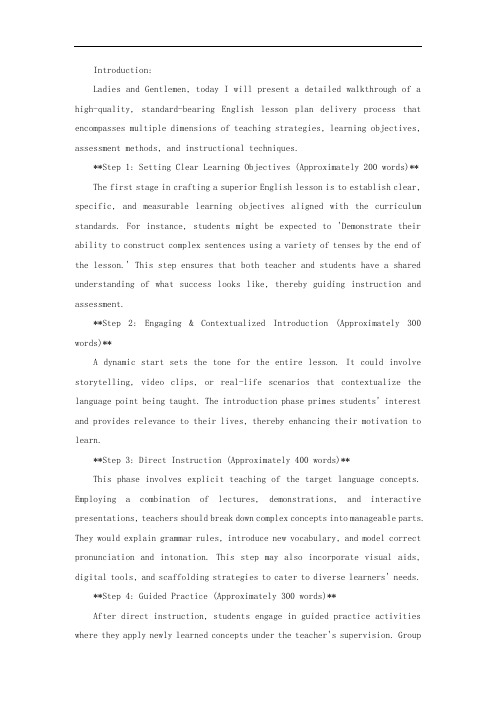
Introduction:Ladies and Gentlemen, today I will present a detailed walkthrough of a high-quality, standard-bearing English lesson plan delivery process that encompasses multiple dimensions of teaching strategies, learning objectives, assessment methods, and instructional techniques.**Step 1: Setting Clear Learning Objectives (Approximately 200 words)** The first stage in crafting a superior English lesson is to establish clear, specific, and measurable learning objectives aligned with the curriculum standards. For instance, students might be expected to 'Demonstrate their ability to construct complex sentences using a variety of tenses by the end of the lesson.' This step ensures that both teacher and students have a shared understanding of what success looks like, thereby guiding instruction and assessment.**Step 2: Engaging & Contextualized Introduction (Approximately 300 words)**A dynamic start sets the tone for the entire lesson. It could involve storytelling, video clips, or real-life scenarios that contextualize the language point being taught. The introduction phase primes students' interest and provides relevance to their lives, thereby enhancing their motivation to learn.**Step 3: Direct Instruction (Approximately 400 words)**This phase involves explicit teaching of the target language concepts. Employing a combination of lectures, demonstrations, and interactive presentations, teachers should break down complex concepts into manageable parts. They would explain grammar rules, introduce new vocabulary, and model correct pronunciation and intonation. This step may also incorporate visual aids, digital tools, and scaffolding strategies to cater to diverse learners' needs.**Step 4: Guided Practice (Approximately 300 words)**After direct instruction, students engage in guided practice activities where they apply newly learned concepts under the teacher's supervision. Groupwork, pair work, role-plays, or written exercises can provide opportunities for active engagement. Teachers give immediate feedback, correcting errors and reinforcing correct usage, thus ensuring a deepened understanding and retention.**Step 5: Independent Practice (Approximately 200 words)**In this stage, students demonstrate their autonomy in applying the learned skills through independent tasks. This could include writing assignments, reading comprehension tasks, or project-based work. It’s crucial to design these tasks so that they promote critical thinking and creativity while reinforcing the lesson objectives.**Step 6: Assessment and Feedback (Approximately 200 words)**Assessment is an integral part of the learning process. Formative assessments such as quizzes, class discussions, and peer evaluations take place throughout the lesson to monitor progress and identify misconceptions. Summative assessments at the end of the lesson provide a more comprehensive view of student mastery. Providing timely, constructive, and individualized feedback allows for reflection and improvement.**Step 7: Reflection and Review (Approximately 100 words)**To conclude, a reflective wrap-up session helps students consolidate their learning by reviewing key points and discussing how they've achieved the lesson objectives. Encouraging students to reflect on their learning journey not only reinforces content but also fosters metacognitive skills.**Conclusion (Approximately 81 words)**In summary, a high-quality English lesson is one that follows a structured and engaging process that caters to various learning styles, promotes active participation, and incorporates effective assessment practices. It is iterative and adaptive, constantly evolving based on student feedback and performance data to ensure continuous growth and development in English proficiency.By following this multifaceted approach, we uphold the principles of quality education, setting high standards for our students' language acquisition and nurturing their passion for English.Total word count: 1581 wordsPlease note, each section above serves as a brief overview. In actual implementation, each step could be expanded upon extensively to reach the desired depth and detail.。
- 1、下载文档前请自行甄别文档内容的完整性,平台不提供额外的编辑、内容补充、找答案等附加服务。
- 2、"仅部分预览"的文档,不可在线预览部分如存在完整性等问题,可反馈申请退款(可完整预览的文档不适用该条件!)。
- 3、如文档侵犯您的权益,请联系客服反馈,我们会尽快为您处理(人工客服工作时间:9:00-18:30)。
高年级英语说课基本流程
一、说教材
1.说教材内容
例:我说课的内容是……年级关于……这一个功能话题。
这一段内容主要通过……和……的对话,让学生学会用……这几个句型进行……的英语会话。
授课时间为40分钟。
2、说教学目标
例:根据对教学内容的分析,我制定了以下几个教学目标:
知识目标:能听懂会说会读会拼写单词和词组(四会)……能听懂会说会读单词和词组(三会)……
能熟练用句型……进行……话题的对话(三会)
能听懂会说会读会拼写句型(四会)……
能力目标:
情感目标:对学生进行……方面的文化意识渗透教学或思想教育(看情况而定,也可省略)
3.说重点难点
例:教材的重点是……
难点是……(从教学目标中具体制定)
二、说教法学法
1.说教法
例:根据教材内容和新课标精神,我在教学中采用以下教学方法:(任务型教学法、创设情境法、知识迁移法、媒体演示法、角色扮演法等等等等,根据教学过程的设计进行简单的说明)
2.说学法
例:根据学生的年龄特点和知识基础,我在教学中为学生设计了以下学习方法:(小组合作法、游戏激趣法、角色扮演法、自主学习法、儿歌记忆法等等,也是根据教学设计确定,并进行简单的说明)
3.说教学准备
教师准备:教具、教室布置、练习纸,课件等等
学生准备:知识准备、资料准备(都是根据具体内容确定)
三、说教学过程
(每一个教学步骤除了简明扼要地说明每一个教学活动外,还要进行简单的设计意图的分析,着重从教法和学法两方面进行评析,用理论来说明你的设计意图,并进行效果的预估。
)
1.Warming up(导入)
这一个环节要设计一些热身活动,如唱与新授有关的英语歌、做个与新授有关的小游戏、与新授有关的对话、与新授有关的单词、词组复习等。
2.Presentation(新授)
要运用任务教学法和情境教学法,在模拟现实的交际对话中教学新授词、句。
千万不要拿着教材一句句教读、跟读。
每个新单词和新句型都要设计环节进行突破。
3.Practice(操练)
在这里主要是回到教材,也可设计一些听力、书写方面的题目,一层层推出教材。
让学生用学会的句子来自学、表演、交流。
4.Activity(活动)
一堂课的高潮部分,也是检查学生本堂课教学效果的环节。
给学生一个活动性的任务,让他们用本堂课所学的句型来用英语做事。
5.Exercise(练习)
让学生完成事先设计的笔头练习,并交流反馈
6.Homework(课外作业)
应该是课堂教学的巩固和延伸,要有趣味性和实用性。
观赏板书。
